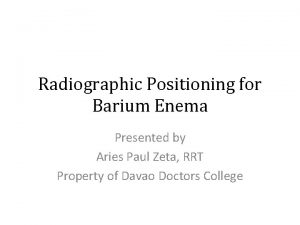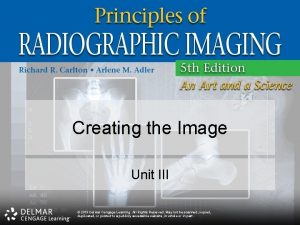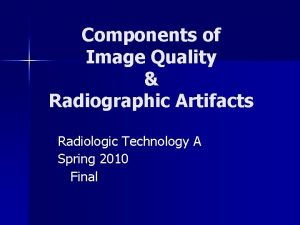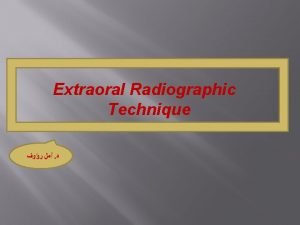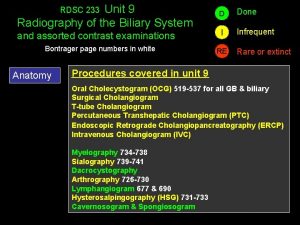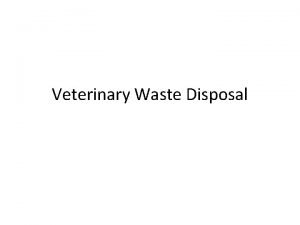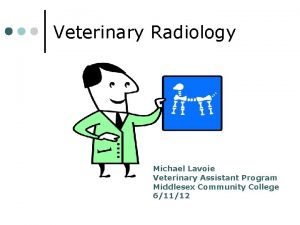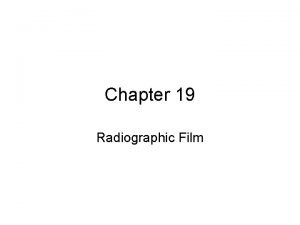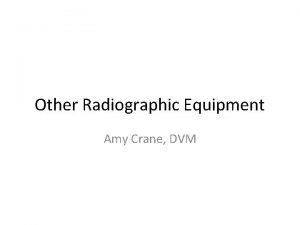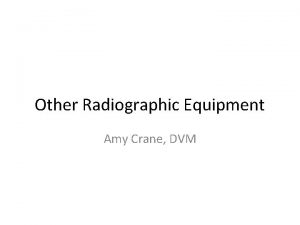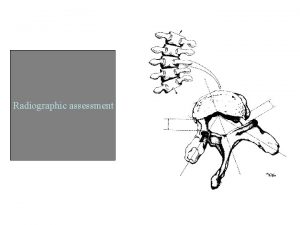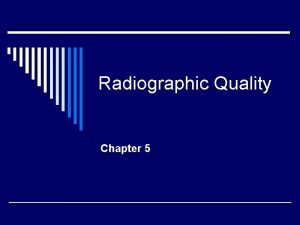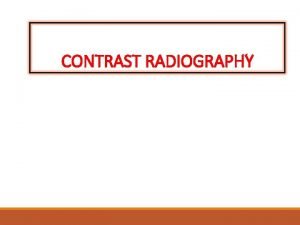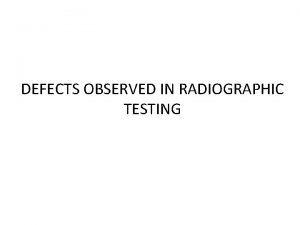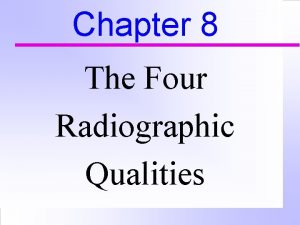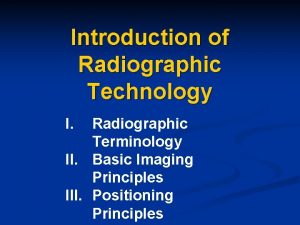Creating a Veterinary Radiographic Technique Chart Amy Crane





















- Slides: 21

Creating a Veterinary Radiographic Technique Chart Amy Crane, DVM

Step 1: Get your radiology house in order ● Have your processor serviced ● Be sure that you are using screens that are all the same age, speed, and manufacturer ● Use a dog that weighs about 40 pounds but is not overweight

Step 2: Select your m. As ● In veterinary medicine, patient motion is a great concern ● We like to use a high m. As and low k. Vp technique

Step 2: Select your m. As cont. ● The following are recommended m. As based on a par (medium, 200) speed intensifying screen –Tabletop (no grid) extremity: –Thorax: –Abdomen: –Spine: ● Important to note the difference between the m. As settings in regions!!!!!!

Step 2: Select your m. As cont ● If your x-ray machine only has one m. A station you just select your m. A and pick the speed to give you the desired m. As. ● For example: if you have a 300 m. A station and you wanted to use a 5 m. As for a thoracic technique chart you would pick – 300 m. A x 1/120 sec = 2. 5 m. As (extremity) – 300 m. A x 1/60 sec = 5 m. As (thorax) – 300 m. A x 1/40 sec = 7. 5 m. As (abdomen) – 300 m. A x 1/30 sec = 10 m. As (spine)

Step 2: Select your m. As cont ● If your x-ray machine has two m. A stations I suggest that for extremity techniques you use the smaller of the m. A stations (usually 100 m. A) and for all other applications you use the larger m. A station (usually 300 m. A). In this case your settings would be as follows:

Step 2: Select your m. As cont – 100 m. A x 1/40 sec = 2. 5 m. As (extremity) – 300 m. A x 1/60 sec = 5 m. As (thorax) – 300 m. A x 1/40 sec = 7. 5 m. As (abdomen) – 300 m. A x 1/30 sec = 10 m. As (spine)

Step 2: Select your m. As cont ● *****The previous suggestions were for par (medium, 200) speed intensifying screens

Step 3: Select your initial k. Vp ● This step is to create a “perfect” radiograph ● To do that we need to find a k. Vp to go along with our suggested m. As setting

Step 3: Select your initial k. Vp ● To pick a starting k. Vp use Sante’s Rule

Step 3: Select your initial k. Vp ● If you are using a…. . – 5: 1 grid add – 8: 1 grid add – 12: 1 grid add

Step 3: Select your initial k. Vp ● Most veterinary applications use an 8: 1 grid ● If you know you are using a grid, but don’t know what kind of grid is under your table assume it is an 8: 1 grid ● Remember, grids are not used in table top techniques ● If you are making a technique chart for a table top study use 0 for the grid factor

Step 4: Expose the Perfect Film ● The goal in this step is to obtain a radiograph with a “perfect” exposure ● The technique you use to generate this radiograph will be used to create the rest of the technique chart. ● ● Take your time and make this radiograph as good as it can be It may take 5 or 6 tries to get it right but the time you spend on this step will be worth it in the end

Step 4: Expose the Perfect Film ● To get started, take a radiograph with the m. As I recommended above for each particular study, and set your k. Vp according to Sante’s Rule ● For example: if I were creating an abdominal technique, using a 40 inch SID, an 8: 1 grid, and my dog measures 15 cm then I would expose a radiograph at 7. 5 m. As and 80 k. Vp. ● Hopefully, that exposure will be in the ballpark and the radiograph will be fairly well exposed

Step 4: Expose the Perfect Film ● Unfortunately, this is not always the case ○ first look at film density

Step 4: Expose the Perfect Film ● Once density is good now time to perfect contrast by changing the k. Vp

Step 5: Make the Technique Chart ● Now that you have a properly exposed radiograph, you are over the hump and the rest is easy ● To create a technique chart simply start with your “perfect exposure” and extrapolate to find the values of k. Vp for other measurements according to the following rules

Step 5: Make the Technique Chart ● Subtract 2 k. Vp from the original k. Vp for each cm decrease from the original measurement ● Add 2 k. Vp to the original k. Vp for each cm increase from the original measurement up to 80 k. Vp ● Add 3 k. Vp for each cm increase that places the kvp above 80 up to 100 ● Add 4 k. Vp for each cm increase that places the k. Vp above 100

Step 5: Make the Technique Chart ● For example…let’s say that we started with a perfect exposure of 7. 5 m. As at 80 k. Vp and our patient measured 15 cm ● We would make an abdominal technique chart as follows

Step 6: Create a technique chart for each different study as abdomen, thorax, extremity, spine Repeat the above process to create these additional technique charts

Also remember every animal is different fat thin muscular/dense puppy/kitten exotic so settings (k. Vp) may need to be changed a little bit need to evaluate every film as it comes out
 Mandible x ray positioning towne's
Mandible x ray positioning towne's Barium enema procedure positioning
Barium enema procedure positioning Grid conversion factors
Grid conversion factors Single door dark room
Single door dark room Radiographic errors in dentistry ppt
Radiographic errors in dentistry ppt X ray pns waters view
X ray pns waters view Sid and oid
Sid and oid Lamina dura of teeth
Lamina dura of teeth Radiographic film
Radiographic film Radiographic artifacts
Radiographic artifacts Reverse towne projection
Reverse towne projection Radiographic films
Radiographic films Geometric unsharpness of margins in radiographic image:
Geometric unsharpness of margins in radiographic image: Dacrocystogram
Dacrocystogram Do they intubate you for general anesthesia
Do they intubate you for general anesthesia Crane signal dog everything
Crane signal dog everything Excel module 1: creating a worksheet and a chart
Excel module 1: creating a worksheet and a chart Veterinary waste disposal
Veterinary waste disposal Middlesex radiology
Middlesex radiology Father of veterinary parasitology
Father of veterinary parasitology Veterinary medicines directorate
Veterinary medicines directorate Bcse sample test
Bcse sample test

